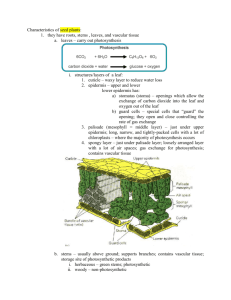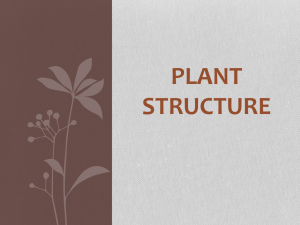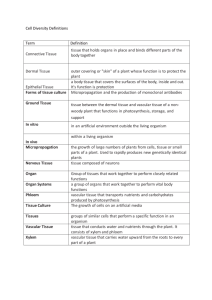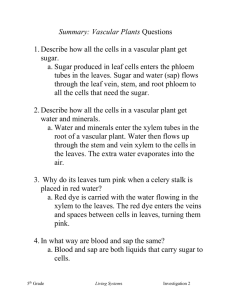- White Rose Research Online
advertisement
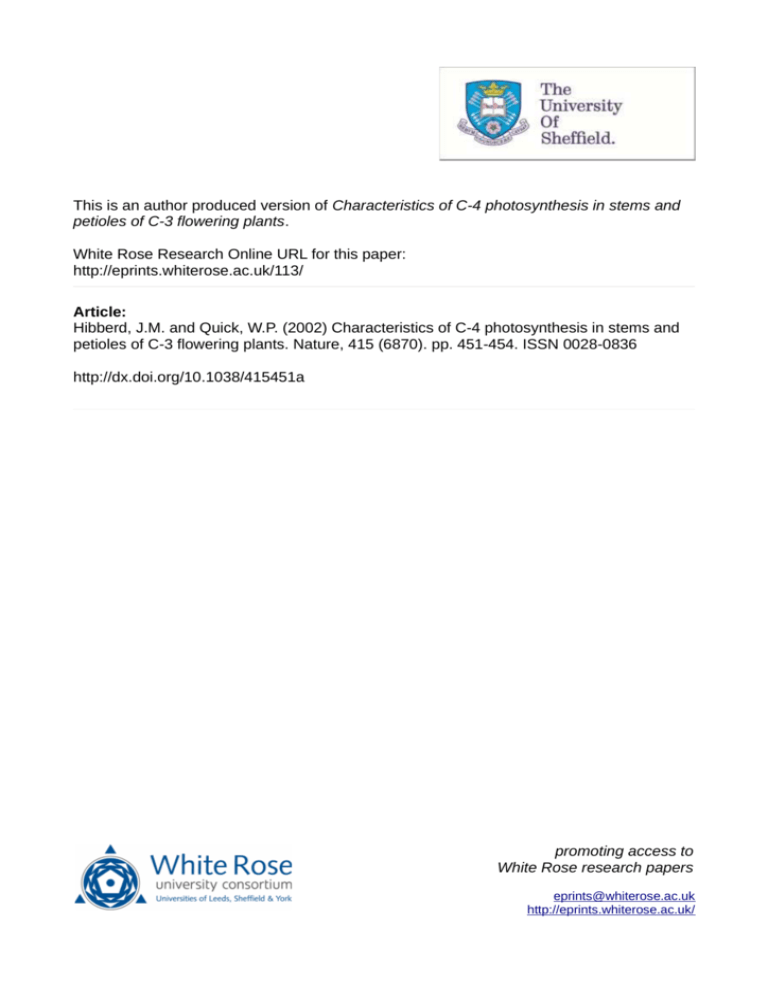
!∀#∃!%&∋((∋)∗ ∗+, −. ∗+ /0!,1&234(),1+,1,5660((∋3+(32 7 /((3,1,1 8 letters to nature ................................................................. Most plants are known as C3 plants because the ®rst product of photosynthetic CO2 ®xation is a three-carbon compound1. C4 plants, which use an alternative pathway in which the ®rst product is a four-carbon compound, have evolved independently many times and are found in at least 18 families2,3. In addition to differences in their biochemistry, photosynthetic organs of C4 plants show alterations in their anatomy and ultrastructure4. Little is known about whether the biochemical or anatomical characteristics of C4 photosynthesis evolved ®rst. Here we report that tobacco, a typical C3 plant, shows characteristics of C4 photosynthesis in cells of stems and petioles that surround the xylem and phloem, and that these cells are supplied with carbon for photosynthesis from the vascular system and not from stomata. These photosynthetic cells possess high activities of enzymes characteristic of C4 photosynthesis, which allow the decarboxylation of four-carbon organic acids from the xylem and phloem, thus releasing CO2 for photosynthesis. These biochemical characteristics of C4 photosynthesis in cells around the vascular bundles of stems of C3 plants might explain why C4 photosynthesis has evolved independently many times. Photosynthesis forms the basis on which all ecosystems on Earth function. The biochemical pathways of photosynthesis are highly conserved. Most plants are C3 plants, in which the ®rst product of photosynthesis is the three-carbon compound phosphoglyceric acid1. A second biochemical pathway that allows the concentration of CO2 in leaves has evolved in C4 plants, which initially ®x inorganic carbon in mesophyll cells into the four-carbon compound oxaloacetic acid. In C4 plants, oxaloacetate is converted into malate or aspartate, which then diffuses into bundle sheath cells that surround the vascular bundles where decarboxylation supplies high concentrations of CO2 to Rubisco. The C4 pathway is thought to have evolved independently 31 times in 18 taxonomic families of angiosperms, and occurs in 8,000 to 10,000 species2,3. The presence of C4 photosynthesis in unicellular algae has also been reported5. In higher plants the C4 pathway involves both biochemical and anatomical modi®cations, but it is not clear which of these modi®cations evolved ®rst2,6. Some plants that possess characteristics of both C3 and C4 plants have been classi®ed as C3 ±C4 intermediates7, and these may represent transitional stages in the evolution of C4 photosynthesis from C3 photosynthesis. In C3 ±C4 intermediates, a photorespiratory cycle has been reported to shunt the precursors of photorespiratory CO2 from the mesophyll to the bundle sheath8,9; in addition, it has been proposed that a pathway that recaptures CO2 lost during photorespiration and that concentrates CO2 around Rubisco in bundle sheath cells represents the ®rst step in C4 evolution6,7. Figure 1 Distribution of chlorophyll in petioles of celery and tobacco. a, Transverse section of celery. b, Longitudinal section of celery. c, Transverse section of tobacco. d, Longitudinal section of tobacco. e, Confocal laser scanning microscope image showing chlorophyll ¯uorescence around the vascular system. f, Confocal laser scanning microscope image showing chloroplasts (red) in between the xylem vessels (green). Scale bars, 2.6 mm (a, b); 1.0 mm (c); 1.1 mm (d); 175 mm (e); 25 mm (f). Figure 2 Incorporation of 14C into insoluble material in cells around the vascular system of celery and tobacco. a, Transverse section of celery after [14C]NaHCO3 was fed to the xylem stream. Scale bar, 4.5 mm. b, Longitudinal section of tobacco showing 14C ®xed into starch after [14C]NaHCO3 was supplied to the xylem stream. Scale bar, 2.3 mm. c, Leaves from tobacco show that when malate with a 14C label on the C4 position is supplied to the xylem stream, 14C is ®xed in cells surrounding the vascular system. Young to old leaves are shown left to right. Scale bar, 14 mm. Characteristics of C4 photosynthesis in stems and petioles of C3 ¯owering plants Julian M. Hibberd* & W. Paul Quick² * Department of Plant Sciences, University of Cambridge, Downing Street, Cambridge CB2 3EA, UK ² Robert Hill Institute, Department of Animal and Plant Sciences, University of Shef®eld, Western Bank, Shef®eld S10 2TN, UK .............................................................................................................................................. NATURE | VOL 415 | 24 JANUARY 2002 | www.nature.com © 2002 Macmillan Magazines Ltd 451 letters to nature Three separate biochemical pathways have evolved to decarboxylate the C4 acid in the bundle sheath cells and thus supply Rubisco with CO2; however, we know little about how these different pathways evolved. In addition to the limited number of biochemical pathways that allow ®xation of inorganic carbon in ¯owering plants, there are few exceptions to the normal route that CO2 takes to reach the sites of ®xation. The pathway of CO2 moving into a plant through stomata is almost universal in vascular land plants. Notable exceptions are submerged aquatic members of the Isoetaceae that do not produce stomata on submerged leaves and vary in their ability to form stomata on aerial leaves10. For example, the CAM (crassulacean acid metabolism) plant Stylites andicola, which is a rare ally of ferns, does not possess stomata and CO2 is transferred to the leaves through its root system11. In Cuscuta re¯exa, a parasitic plant in which stomata have become modi®ed into extra¯oral nectaries, CO2 ®xed in photosynthesis is derived internally from respiration12. We studied a group of photosynthetic cells surrounding the vascular tissue of stems and petioles in tobacco that continue their association with vascular bundles well into the leaf tissue. Even in C3 plants, cells around the veins are termed `bundle sheath' cells13,14. Although these photosynthetic cells are evident to the naked eye in plants such as celery (Fig. 1a, b), they have not been included in classi®cations of stem photosynthesis to date15. In transverse and longitudinal sections of celery (Fig. 1a, b) and tobacco (Fig. 1c±e), the most intense regions of chlorophyll accumulation are associated directly with internal vascular structures. Chlorophyll is found preferentially surrounding the xylem and the phloem of the vascular bundles (Fig. 1e), and chlorophyll ¯uorescence from the chloroplasts of cells directly between the xylem vessels can be observed (Fig. 1f). In fact, species from 30 different families that we have so far examined contain chlorophyll around the phloem and xylem vessels (data not shown). In contrast to CO2 movement to all other photosynthetic cells in ¯owering plants, CO2 diffusion from stomata to the photosynthetic cells surrounding the vascular bundles is likely to be slow as there are relatively few stomata, many layers of surrounding cells and very few intercellular air spaces. This lack of air spaces between cells of the a vascular tissue has been previously noted and proposed to reduce diffusion of oxygen to cells that would be prone to oxidative stress16. But the photosynthetic cells that we observed have the potential to generate active oxygen species in cells close to the vascular system. As these photosynthetic cells are not close to stomata but are close to the xylem vessels, we tested whether they ®x inorganic carbon supplied from the xylem stream. Inorganic carbon supplied to roots and stems of tobacco and celery as [14C]NaHCO3 led to accumulation of 14C in insoluble material, most notably starch, in cells associated with the vasculature (Fig. 2a, b). Supplying [14C]glucose to roots (which is taken up by the roots and used in respiration to produce 14CO2) led to 14C in the xylem stream and the same distribution of isotope around the vascular bundles (data not shown). These data show that inorganic carbon surrounding roots can be taken up and ®xed by cells around the xylem, and also that sugars used in respiration in roots give rise to CO2 that moves into xylem vessels and is then ®xed by cells surrounding the xylem. The concentration of CO2 in the xylem sap is dependent on pH, and considerably higher than that in the air17. Supplying inorganic carbon to the roots of plants has been shown to enhance plant growth and productivity18,19, although it should be noted that the growth enhancement is not completely due to ®xation of the additional inorganic carbon supply19,20. The xylem stream of plants often contains organic acids21,22, and the malate found in both phloem and xylem may have a role as a biochemical pH regulator to balance acid and base movement through the plant22,23. We tested whether malate supplied to the transpiration stream would be decarboxylated, and the released CO2 subsequently re-®xed photosynthetically by the cells surrounding the xylem vessels. Feeding malate labelled with 14C in the C4 position (this is the carbon atom that is released during the decarboxylation process) to the xylem stream led to the ®xation of 14C in the veins of the petioles and stems of tobacco (Fig. 2c). Concentrations of malate in the xylem sap of tobacco plants decreased with increasing distances from the base of the plant (0.23 mM at the base to 0.02 mM in expanded leaves)24. Changes in the concentration of malate in the xylem have implications for the acid±base balance of the shoot22, and therefore merit further b Vascular photosynthetic cell Sucrose CO2 Malate Photosynthesis Pyruvate C4 leaf Stem CO2 Malate Malate Bundle sheath Vascular bundle Respiration Malate PEP Xylem C3 stem Sucrose Root cortex cell Phloem Figure 3 Photosynthesis around the veins of C3 and C4 plants. a, Model for the role of photosynthesis around the vascular system of stems and petioles of the C3 plant tobacco. CO2 is supplied from the soil, from respiration in roots or from malate that is produced in the root; either CO2 or malate moves into the xylem stream, which supplies photosynthetic 452 Malate Root CO2 cells lining the vascular system in stems and petioles. b, Comparison of the supply of malate to photosynthetic cells in a C4 leaf and that to photosynthetic cells lining the vascular system in a C3 stem. Both sets of cells that line the vascular system possess high activities of enzymes that can decarboxylate C4 organic acids. © 2002 Macmillan Magazines Ltd NATURE | VOL 415 | 24 JANUARY 2002 | www.nature.com letters to nature investigation. We conclude that these photosynthetic vascular cells scrub the xylem of malate, because the 14C label was restricted to the petiole and basal regions of all leaves in a plant (Fig. 2c). When the plants were left for 24 h (after supplying the transpiration stream with radiolabelled malate for 1 h), we found that 14C no longer remained within the vascular tissues but was transferred to young developing leaves. Placing plants in darkness to close the stomata showed that this process was independent of the transpiration stream. We therefore conclude from this indirect data that sucrose produced from these cells around the vascular bundles is loaded into the phloem and translocated to growing apices. These data indicate that photosynthetic cells around the vasculature make use of organic acids present in the xylem of tobacco. The decarboxylation of malate in cells around the veins of petioles and stems is reminiscent of the decarboxylation of organic acids in the bundle sheath of C4 plantsÐthat is, the cells that surround the vascular bundles of leaves. To test whether decarboxylation enzymes are speci®cally and preferentially expressed in cells around the vascular bundles in the stem of tobacco, we determined the activity of three decarboxylation enzymesÐnicotinamide adenine dinucleotide (NAD)-malic, NADP-malic and phosphoenolpyruvate carboxykinase (PEPCK)Ðindicative of the three C4 subtypes, and compared their activity in these cells with that in the leaf lamina. In cells surrounding the xylem and phloem of tobacco, the activity of NAD-malic enzyme (NAD-ME) was 13-fold higher than in the leaf, and the activity of NADP-malic enzyme (NADP-ME) and PEPCK were both 9-fold higher than in the leaf (Table 1). The activities of these decarboxylation enzymes far exceeds typical values obtained from C3 plants and approaches activities expected in the bundle sheath of C4 plants25,26. These data indicate that in tobacco, a C3 plant, similar biochemical attributes to those needed in C4 photosynthesis are associated with photosynthesis around the vascular system of stems and petioles. Because these enzymes are expressed highly and speci®cally in these cells, the correct regulatory elements controlling gene expression must be present. In agreement with our assays of enzyme activity, when present in tobacco the promoter of a gene coding NADP-ME from bean directs high and speci®c expression of the enzyme in cells surrounding the vascular tissue of stems27. Notably, in the Arabidopsis genome the genes that code these decarboxylases are members of gene families that would allow the differential regulation and tissue-speci®c expression of certain members of each family. The vascular system may be regarded as taking the place of the mesophyll cells of a C4 plant by supplying the surrounding photosynthetic cells with malate. The malate is then decarboxylated, and thus part of the C4 cycle is operating in C3 plants. We also measured high activities of phosphoenol pyruvate orthophosphate dikinase (PPDK; this regenerates PEP from pyruvate in C4 plants) in cells around the vascular system of tobacco petioles (Table 1). The role that the decarboxylases have in cells around the vascular system is not certain. It is possible that by controlling the concentration of malate, they are involved in controlling the pH of the xylem22. In addition, their high activity and the production of PEP through PPDK would allow for high provision of carbon skeletons into the shikimate pathway and thus Table 1 Activities of decarboxylation enzymes and PPDK NAD-ME activity (mmol min-1 per mg Chl) NADP-ME activity (mmol min-1 per mg Chl) PEPCK activity (mmol min-1 per mg Chl) PPDK activity (mmol min-1 per mg Chl) Leaf tissue Vein tissue 0.25 6 0.03 3.15 6 0.22 0.78 6 0.08 6.82 6 1.07 0.003 6 0.0007 0.028 6 0.009 0.30 6 0.05 5.33 6 1.06 Relative enrichment (vein/leaf) 13-fold 9-fold 9-fold 18-fold ............................................................................................................................................................................. ............................................................................................................................................................................. These enzymes are used by C4 plants and are here measured in tobacco. Data shown are means 6 s.e. (n = 8±13). Chl, chlorophyll. NATURE | VOL 415 | 24 JANUARY 2002 | www.nature.com lignin synthesis in exactly the cells where lignin is incorporated into cell walls of the xylem vessels at high rates. From these data we propose the following scheme. In C3 plants, photosynthetic cells surrounding the vascular system are supplied with either malate or CO2 from the xylem vessels (Fig. 3a). CO2 can be supplied from root respiration, or enter the roots from the soil. Malate is produced from PEP because of the presence of phosphoenolpyruvate carboxylase in roots18,28,29. Malate is then decarboxylated by cells bordering the vascular system in the stems of C3 plants, and the CO2 is used in photosynthesis to produce carbohydrates including sucrose and starch (Fig. 3a). The sucrose that is produced can be either used locally to fuel metabolism or loaded into the phloem and translocated to growing regions of the plant. When compared to the system that operates in C4 plants, there are striking parallels (Fig. 3b). Bundle sheath cells of C4 plants are photosynthetic, lie adjacent to vascular tissues, and possess high activities of enzymes that release CO2 from malate. These key attributes of C4 photosynthesis are also characteristics of the photosynthetic cells that surround the vascular bundle in C3 plant stems and petioles that we have identi®ed here. The main difference is the source of malate: in C4 plants, malate is provided by adjacent mesophyll cells; in C3 stems and petioles, malate is derived from the respiratory activity of distant heterotrophic tissues and transported through the vasculature to photosynthetic cells surrounding the vascular system. We propose that the arrangement of photosynthetic cells around vascular bundles of C3 stems is a more spatially separated version of the C4 photosynthetic pathway. Furthermore, the presence of the correct biochemical pathways in cells adjacent to the vascular bundles in the stems and leaf veins of C3 plants indicates that essential biochemical components and the regulatory elements controlling the cell-speci®c gene expression required for C4 photosynthesis are already present in C3 plants; thus, fewer modi®cations are needed for C4 photosynthesis to evolve. The promoter of an NADP-ME gene from bean has been shown to direct expression in cells around the vascular system27. The existence of such a similar pathway in C3 plants provides a simple explanation for the polyM phyletic evolution of C4 photosynthesis. Methods Plants and microscopy Tobacco plants were grown under natural light in a greenhouse with supplementary lighting provided by metal halide bulbs supplying 250 mmol photons m-2 s-1. Plants were used during vegetative growth between 40 and 60 days after planting. We collected and analysed xylem sap as described24. We cut sections for optical and confocal laser scanning microscopy manually with a razor blade. Images of chlorophyll ¯uorecsence were taken using the TRITC channel of a Leica TCS confocal microscope. 14 C labelling and enzyme assays We fed 1 mM [14C]NaHCO3 (speci®c activity 155 MBq mmol-1), 0.1 mM 14C universally labelled glucose (74 MBq mmol-1) or 0.2 mM malate (80 MBq mmol-1) labelled in the C4 position to the roots or stems of tobacco grown hydroponically, and to the stems of celery for 40 min in the light. Plants were left for 30 min, ¯ash frozen, and heated in 70% ethanol to remove soluble sugars; sections were then exposed to X-ray ®lm. We conducted enzyme assays on either leaf lamina of tobacco or the veins of tobacco petioles separated from the cortex manually with a razor blade; results are expressed per unit chlorophyll25,30. Received 13 September; accepted 21 November 2001. 1. Calvin, M. et al. Carbon dioxide assimilation in plants. Symp. Soc. Exp. Biol. 5, 284±305 (1951). 2. Moore, P. D. Evolution of photosynthetic pathways in ¯owering plants. Nature 310, 696 (1982). 3. Sage, R. F., Li, M. & Monson, R. K. in C4 Plant Biology (eds Sage, R. F. & Monson, R. K.) 551±584 (Academic, San Diego, 1999). 4. Hatch, M. D. C4 photosynthesis; a unique blend of modi®ed biochemistry, anatomy and ultrastructure. Biochem. Biophys. Acta 895, 81±106 (1987). 5. Reinfelder, J. R., Kraepiel, A. M. L. & Morel, F. M. Unicellular C4 photosynthesis in a marine diatom. Nature 407, 996±999 (2000). 6. Monson, R. K. in C4 Plant Biology (eds Sage R. F. & Monson, R. K.) 377±410 (Academic, San Diego, 1999). 7. Rawsthorne, S. C3 ±C4 intermediate photosynthesis: linking physiology to gene expression. Plant J. 2, 267±274 (1992). 8. Rawsthorne, S., Hylton, C. M., Smith, A. M. & Woolhouse, H. W. Photorespiratory and immunogold localization of photorespiratory enzymes in leaves of C3 and C3 ±C4 intermediate species of Moricandia. Planta 173, 298±308 (1988). © 2002 Macmillan Magazines Ltd 453 letters to nature 9. Rawsthorne, S., Hylton, C. M., Smith, A. M. & Woolhouse, H. W. Distribution of photorespiratory enzymes between bundle sheath and mesophyll cells in leaves of the C3 ±C4 intermediate species Moricandia arvensis (L.) DC. Planta 176, 527±532 (1988). 10. Keeley, J. E. CAM photosynthesis in submerged aquatic plants. Bot. Rev. 64, 121±175 (1998). 11. Keeley, J. E., Osmond, C. B. & Raven, J. A. Stylites, a vascular land plant without stomata absorbs CO2 via its roots. Nature 310, 694±695 (1984). 12. Hibberd, J. M. et al. Localization of photosynthetic metabolism in the parasitic angiosperm Cuscuta re¯exa. Planta 205, 506±513 (1998). 13. Esau, K. Plant Anatomy 2nd edn (John Wiley, New York, 1965). 14. Kinsman, E. A. & Pyke, K. A. Bundle sheath cells and cell-speci®c plastid development in Arabidopsis leaves. Development 125, 1815±1822 (1998). 15. Nilsen, E. T. in Plant Stems (ed. Gartner, B. L.) 223±240 (Academic, San Diego, 1995). 16. Raven, J. A. Long-term functioning of enucleate sieve elements: possible mechanisms of damage avoidance and damage repair. Plant Cell Environ. 14, 139±146 (1991). 17. Gerendas, J. & Schurr, U. Physicochemical aspects of ion relations and pH regulation in plantsÐa quantitative approach. J. Exp. Bot. 50, 1101±1114 (1999). 18. Cramer, M. D. & Richards, M. B. The effect of rhizosphere dissolved inorganic carbon on gas exchange characteristics and growth rates of tomato seedlings. J. Exp. Bot. 50, 79±87 (1999). 19. Cramer, M. D., Gao, Z. F. & Lips, S. H. The in¯uence of dissolved inorganic carbon in the rhizosphere on carbon and nitrogen metabolism in salinity treated tomato plants. New Phytol. 142, 441±450 (1999). 20. Vuorinen, A. R., Rossi, P. & Vapaavuori, E. M. Combined effect of inorganic carbon and different nitrogen sources in the growth media on biomass production and nitrogen uptake in young willow and birch plants. J. Plant Physiol. 147, 236±242 (1995). 21. Pate, J. S. in Encylopedia of Plant Physiology Vol. 1 (eds Zimmerman, M. H. & Milburn, J. A. ) 451±473 (Springer, Heidelberg, 1975). 22. Raven, J. A. & Smith, F. A. Nitrogen assimilation and transport in vascular land plants in relation to intracellular pH regulation. New Phytol. 76, 415±431 (1976). 23. Ben Zioni, A., Vaadia, Y. & Lips, S. H. Nitrate uptake by roots as regulated by nitrate reduction products of the shoot. Physiol. Plant. 24, 288±290 (1971). 24. Hibberd, J. M., Quick, W. P., Press, M. C., Scholes, J. D. & Jeschke, W. D. Solute ¯uxes from tobacco to the parasitic angiosperm Orobanche cernua and the in¯uence of infection on host carbon and nitrogen relations. Plant Cell Environ. 22, 937±947 (1999). 25. Ashton, A. R., Burnell, J. N., Furbank, R. T., Jenkins, C. L. D. & Hatch, M. D. in Methods in Plant Biochemistry, Vol. 3 (ed. Lea, P. J.) 39±72 (Academic, San Diego, 1990). 26. Lea, P. J. & Leegood, R. C. Plant Biochemistry and Molecular Biology (Wiley, Chichester, 1999). 27. Schaaf, J., Walter, M. H. & Hess, D. Primary metabolism in plant defence. Plant Physiol. 108, 949±960 (1995). 28. Gao, Z., Sagi, M. & Lips, M. Assimilate allocation priority as affected by nitrogen compounds in the xylem sap of tomato. Plant Physiol. Biochem. 34, 807±815 (1996). 29. Thomas, J. C., De Armond, R. L. & Bohnert, H. J. In¯uence of NaCl on growth, proline and phosphoenolpyruvate carboxylase levels in Mesembryanthemum crystallinum suspension cultures. Plant Physiol. 98, 626±631 (1992). 30. Walker, R. P., Trevanion, S. J. & Leegood, R. C. Phosphenolpyruvate carboxykinase from higher plants: Puri®cation from cucumber and evidence of rapid proteolytic cleavage in extracts from a range of plant tissues. Planta 196, 58±63 (1995). Acknowledgements We thank J. C. Gray and W. D. Jeschke for discussions. J.M.H. thanks the BBSRC for a Sir David Phillips Research Fellowship. Competing interests statement The authors declare that they have no competing ®nancial interests. Correspondence and requests for materials should be addressed to J.M.H. (e-mail: julian.hibberd@plantsci.cam.ac.uk). ................................................................. Anaerobic microbial metabolism can proceed close to thermodynamic limits Bradley E. Jackson & Michael J. McInerney Department of Botany and Microbiology, University of Oklahoma, 770 Van Vleet Oval, Norman, Oklahoma 73019-2045, USA .............................................................................................................................................. Many fermentative bacteria obtain energy for growth by reactions in which the change in free energy (DG9) is less than that needed to synthesize ATP1±4. These bacteria couple substrate metabolism directly to ATP synthesis, however, by classical phosphoryl transfer reactions4,5. An explanation for the energy economy of these organisms is that biological systems conserve energy in discrete 454 amounts3,4, with a minimum, biochemically convertible energy value of about -20 kJ mol-1 (refs 1±3). This concept predicts that anaerobic substrate decay ceases before the minimum free energy value is reached, and several studies support this prediction1,6±9. Here we show that metabolism by syntrophic associations, in which the degradation of a substrate by one species is thermodynamically possible only through removal of the end product by another species1, can occur at values close to thermodynamic equilibrium (DG9 < 0 kJ mol-1). The free energy remaining when substrate metabolism halts is not constant; it depends on the terminal electron-accepting reaction and the amount of energy required for substrate activation. Syntrophic associations metabolize near thermodynamic equilibrium, indicating that bacteria operate extremely ef®cient catabolic systems. Anaerobic bacteria capable of syntrophic metabolism thrive in environmental niches where amounts of free energy are at a minimum1, and therefore represent ideal microbial systems for testing bioenergetic concepts. In syntrophic associations, the degradation of a substrate by one species is made thermodynamically possible through the removal of end products by another species (ref. 1; and Table 1). Syntrophic interactions are widespread, occurring in both manmade and natural environments such as sewage digesters, municipal land®lls, hydrocarbon-contaminated soils, freshwater sediments and waterlogged soils1,10±12. The ubiquity of such interactions emphasizes the fact that, in most environments, metabolic cooperation among microbial species is required for the complete destruction of organic matter1,12. We observed previously that syntrophic cultures only partially degrade their substrate, stopping at a threshold concentration7,13. The resulting substrate threshold was large in some cases, up to 1.5 mM, and remained unchanged for up to 360 days of incubation13. Experiments have shown that nutritional limitation, loss of metabolic activity, inhibition by high hydrogen or formate concentrations, kinetic inhibition and toxicity from build-up of the undissociated form of acetate are not the cause of this threshold7,8,13. The substrate threshold concentration was, however, in¯uenced by the accumulation of end product (speci®cally acetate). We concluded that the extent of substrate degradation was controlled by a thermodynamic, mass-action effect7,13. By manipulating substrate degradation and threshold formation, we tested the hypothesis that a minimum quantum of free energy is needed to sustain microbial metabolism. On the basis of universal biological energy quantum theory1±3, we posited the following predictions: ®rst, substrate degradation will cease at a threshold concentration that corresponds to a critical free energy value (DG9crit) independent of the species or substrate involved; second, the DG9crit value at threshold will be constant (not appreciably lower or higher than -20 kJ mol-1); and third, the DG9crit will not be affected by different substrates or terminal electron-accepting schemes. Benzoate and butyrate were used as model substrates, because each of these is a key intermediate in the degradation of diverse organic compounds3,12,14. Each compound was added to de®ned cocultures containing a syntrophically oxidizing bacterium and a hydrogen-consuming partner. Table 2 shows the results of butyrate degradation by a typical Syntrophus aciditrophicus coculture grown under sulphate-reducing conditions (with Desulfovibrio sp. strain G11) when stressed with different concentrations of acetate. Roughly 2.5 mM butyrate was degraded incompletely to a threshold concentration that ranged from 5 to 250 mM, depending on the ®nal concentration of acetate. Hydrogen partial pressures were low, ranging from 0.22 6 0.06 to 0.31 6 0.05 Pa, and formate was not detected (detection limit of 1 mM). The extent of butyrate degradation depended on the amount of acetate in the system, which is consistent with the interpretation that the accumulation of end products thermodynamically controls the extent of substrate degradation. Even though the ®nal butyrate © 2002 Macmillan Magazines Ltd NATURE | VOL 415 | 24 JANUARY 2002 | www.nature.com
